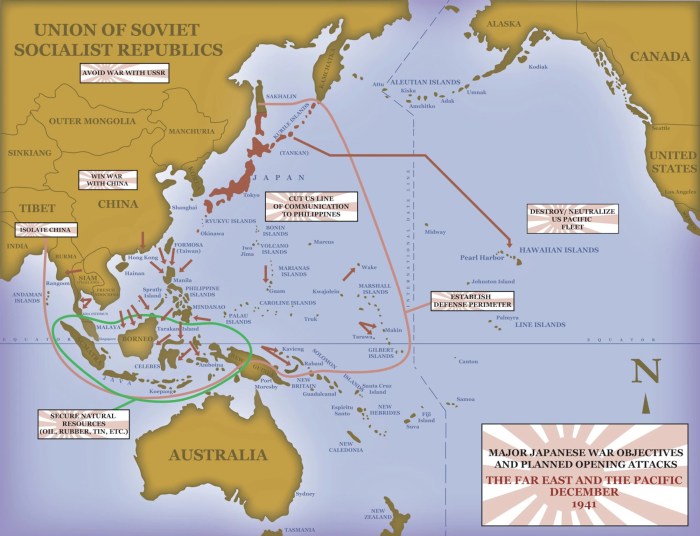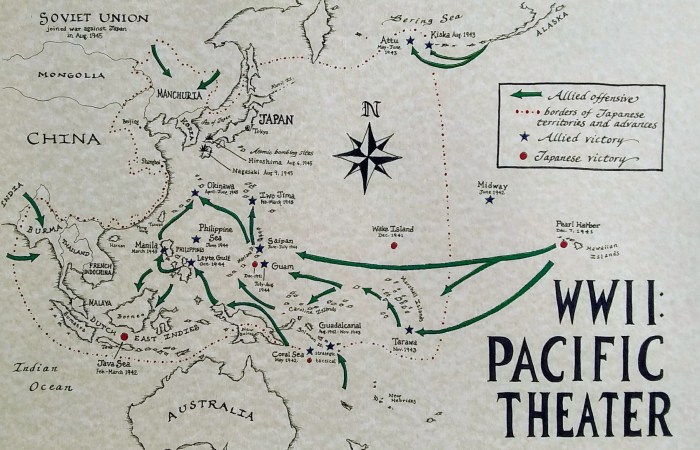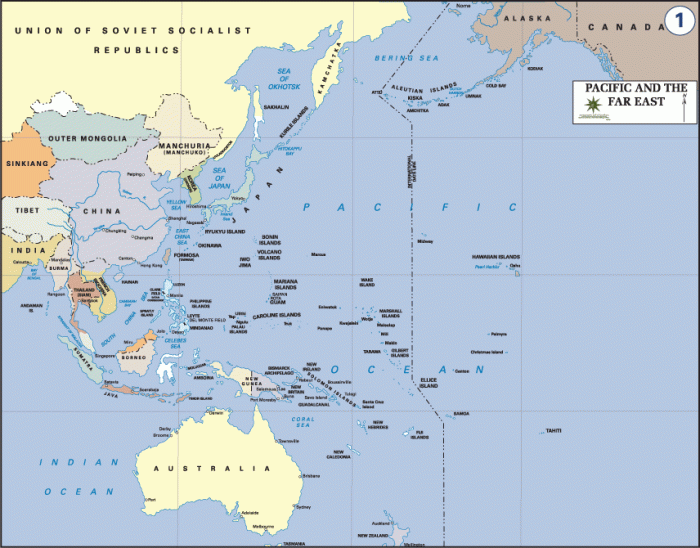Blank map of pacific theater ww2 – The blank map of the Pacific Theater of World War II serves as a valuable tool for understanding the strategic importance and historical significance of this theater of operations. It provides a visual representation of the major battles and campaigns, allowing for a deeper analysis of the factors that contributed to the Allied victory and the challenges they faced.
The map includes key geographical features such as islands, oceans, and countries, as well as the locations of key battles and campaigns. This visual aid enhances the understanding of the vastness of the Pacific Theater and the complexity of the military operations that took place within it.
Pacific Theater of World War II: Blank Map Of Pacific Theater Ww2

The Pacific Theater was a major theater of operations during World War II, encompassing the vast expanse of the Pacific Ocean and the islands within it. The theater was strategically crucial due to its control over vital sea routes, natural resources, and military bases.
The Pacific Theater witnessed a series of intense battles and campaigns, including the attack on Pearl Harbor, the Battle of Midway, the Guadalcanal Campaign, the Battle of Iwo Jima, and the Battle of Okinawa. These battles were characterized by fierce naval and air combat, amphibious landings, and protracted ground campaigns.
Key Players
The Pacific Theater featured a cast of key players, including:
- United States:The United States played a dominant role in the Pacific Theater, providing the bulk of the military forces and resources.
- Japan:Japan was the primary aggressor in the Pacific Theater, seeking to expand its empire and control key strategic territories.
- Great Britain:Great Britain contributed significant naval and air forces to the Allied effort in the Pacific Theater.
li> Australia:Australia played a crucial role in the defense of the Southwest Pacific and provided logistical support to Allied forces.
Blank Map of the Pacific Theater

To better visualize the vast expanse of the Pacific Theater during World War II, it is helpful to create a blank map that includes key geographical features, battles, and campaigns.
Creating the Blank Map
Begin by drawing the Artikels of the major landmasses, including Asia, Australia, and the islands of the Pacific Ocean. Mark the locations of major cities, such as Tokyo, Manila, and Sydney. Include the major oceans, such as the Pacific Ocean and the South China Sea.
Marking Key Battles and Campaigns
Once the basic map is complete, mark the locations of key battles and campaigns. This can include major naval battles, such as the Battle of Midway and the Battle of the Coral Sea, as well as land campaigns, such as the Guadalcanal Campaign and the New Guinea Campaign.
Analysis of the Pacific Theater

The Pacific Theater of World War II was a vast and complex theater of operations that spanned the Pacific Ocean and Southeast Asia. The Allies, led by the United States, fought against the Axis powers, led by Japan, for control of the region.
The Pacific Theater was characterized by a number of unique challenges, including the vast distances involved, the difficulty of supplying and supporting troops in the field, and the complex terrain. Despite these challenges, the Allies were ultimately victorious in the Pacific Theater.
Factors Contributing to Allied Victory
- Industrial superiority:The United States had a圧倒的な(圧倒的な) industrial advantage over Japan. This allowed the Allies to produce more ships, planes, and other weapons than the Japanese.
- Technological superiority:The Allies also had a technological advantage over Japan. This included the development of new weapons, such as the atomic bomb, which helped to end the war.
- Strategic leadership:The Allies were able to develop and implement a successful strategy for defeating Japan. This strategy involved isolating Japan from its resources, cutting off its supply lines, and bombing its cities.
- Allied cooperation:The Allies were able to cooperate effectively with each other, despite their different languages, cultures, and political systems.
Challenges Faced by the Allies, Blank map of pacific theater ww2
- Vast distances:The Pacific Ocean is a vast and empty space. This made it difficult for the Allies to supply and support their troops in the field.
- Difficult terrain:The Pacific Theater was characterized by a number of difficult terrain features, such as jungles, mountains, and islands. This made it difficult for the Allies to move their troops and supplies.
- Japanese tenacity:The Japanese were a tenacious enemy. They fought hard and often to the death. This made it difficult for the Allies to defeat them.
Comparison to Other Theaters of World War II
- Size:The Pacific Theater was the largest theater of operations in World War II. It covered an area of over 100 million square miles.
- Scope:The Pacific Theater was also the most complex theater of operations in World War II. It involved a number of different countries and cultures.
- Casualties:The Pacific Theater was one of the deadliest theaters of operations in World War II. Over 2 million people were killed in the Pacific Theater, including over 1 million Americans.
Impact of the Pacific Theater

The Pacific Theater of World War II was a vast and complex conflict that had a profound impact on the course of the war and the world.
The Pacific Theater was the largest naval theater of the war, and it saw some of the most intense and bloody fighting of the conflict. The Japanese attack on Pearl Harbor in 1941 brought the United States into the war, and the fighting in the Pacific quickly escalated.
The Japanese quickly conquered a vast empire in the Pacific, but the United States and its allies gradually began to push them back.
Legacy of the Pacific Theater
The legacy of the Pacific Theater is complex and far-reaching. The war had a devastating impact on the people of the Pacific, and it left a lasting legacy of destruction and suffering.
- The war resulted in the deaths of millions of people, both military and civilian.
- The war caused widespread destruction of infrastructure and property.
- The war had a profound impact on the environment, including the detonation of nuclear weapons at Hiroshima and Nagasaki.
The Pacific Theater also had a significant impact on the political and economic development of the region. The war led to the decolonization of many Asian and Pacific countries, and it helped to shape the Cold War rivalry between the United States and the Soviet Union.
Personal Stories and Experiences from the Pacific Theater
The Pacific Theater was a brutal and unforgiving environment, and the men and women who fought there endured unimaginable hardships.
“I saw things in the Pacific that I will never forget,” said one veteran. “I saw men die in horrible ways. I saw men go insane. I saw men lose their faith in God.”
Despite the horrors of war, the men and women of the Pacific Theater also showed great courage and resilience.
“We were all scared,” said another veteran. “But we knew that we had to fight for what was right. We had to fight for our country and for our freedom.”
The stories and experiences of the men and women who fought in the Pacific Theater are a testament to the human spirit. They are a reminder of the horrors of war, but they are also a reminder of the courage and resilience of the human spirit.
Questions and Answers
What was the strategic importance of the Pacific Theater in World War II?
The Pacific Theater was crucial for controlling access to vital resources, such as oil and rubber, and for securing sea routes between the United States and its allies in Asia.
What were the major battles and campaigns in the Pacific Theater?
Key battles and campaigns included the Battle of Midway, the Guadalcanal Campaign, the Battle of Iwo Jima, and the Battle of Okinawa.
Who were the key players in the Pacific Theater?
Key players included General Douglas MacArthur, Admiral Chester Nimitz, and Japanese Admiral Isoroku Yamamoto.

